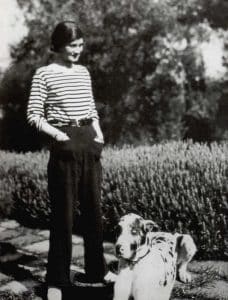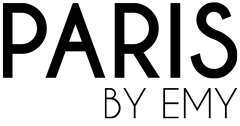|Coco Chanel, rebellious elegance|
Coco Chanel history : Parisian icon, she has transgressed the stylistic codes of an ultra-corseted era to liberate women in their body and soul. Androgynous look, through straight dresses and the pants previously reserved for men, Coco embodies the free and liberated woman, as a designer, perfumer, jeweler and business woman.

Coco Chanel Timeline
Early Life
- 1883: Gabrielle Bonheur “Coco” Chanel is born on August 19 in Saumur, France.
- 1895: Chanel’s mother dies, and her father sends her and her sisters to an orphanage at the convent of Aubazine.
Early Career
- 1901: Chanel leaves the orphanage and moves to Moulins to work as a seamstress and cabaret singer. She adopts the nickname “Coco” during this time.
- 1908: Chanel becomes the mistress of textile heir Étienne Balsan and is introduced to society life.
Fashion Beginnings
- 1910: With financial support from Balsan, Chanel opens her first hat shop, Chanel Modes, at 21 Rue Cambon in Paris.
- 1913: Chanel opens a boutique in Deauville, offering casual clothing suitable for leisure and sports.
- 1915: Opens a couture house in Biarritz, which becomes a success due to its clientele of wealthy Spanish customers.
Rise to Fame
- 1919: Chanel’s lover, Boy Capel, dies in a car accident, profoundly affecting her.
- 1921: Launches her first perfume, Chanel No. 5, which becomes a timeless classic.
- 1924: Introduces her first costume jewelry collection.
- 1925: Introduces the iconic Chanel suit, emphasizing comfort and simplicity.
- 1926: Debuts the little black dress, which becomes a staple in women’s fashion.
Expansion and Influence
- 1931: Chanel travels to Hollywood to design costumes for MGM studios.
- 1939: Closes her fashion house at the outbreak of World War II but keeps her perfume and accessories business running.
Later Life
- 1954: At age 71, Chanel reopens her couture house, introducing a new line that receives mixed reviews in France but is highly praised in the U.S.
- 1955: Introduces the Chanel 2.55 handbag, which becomes iconic.
- 1971: Coco Chanel dies on January 10 at the Hotel Ritz in Paris, where she had lived for more than 30 years.
Legacy
- 1983: Karl Lagerfeld takes over as chief designer for the House of Chanel, continuing to innovate while preserving Chanel’s legacy.
- Present: The brand continues to be one of the most prestigious in the world, known for its luxury fashion, fragrances, and accessories.
Coco Chanel’s influence on fashion remains significant, and her creations continue to inspire designers and fashion enthusiasts globally.
The beginning of Coco Chanel history
Coco Chanel, born Gabrielle Bonheur Chasnel, was born in Saumur, August 19, 1883. At the age of 12, following the death of her mother, her father decided to place her and her 2 sisters in the Cistercian abbey of Aubazine orphanage. This life period influenced her stylistic signature : strict cuts, monastic colors and a cult of purity. Several signature pieces such as pajamas, which can be worn both on the beach and in the evening, the tweed suit and the little black dress which, until then, was reserved for periods of mourning become her label.
Her protector, Etienne Balsan
At 18, Gabrielle Chanel joined her aunt in Moulins at the very center of France and began her career in 1903 in a workshop which produced keychains and layettes. In 1907, drawn to the scene, Coco Chanel sang in café concert nearby Moulins train station. She keeps her nickname “Coco” from that time because she sang “Who did coco see on the Trocadero?” ” There she will meet her future protector, Etienne Balsan, who will introduce her to worldly life. In 1906, Coco Chanel accepted the invitation of Etienne Balsan and followed him to Compiègne. History is just beginning…
Arthur “Boy” Capel, the great love of Coco Chanel
Etienne Balsan introduced her to Arthur “Boy” Capel, the great love of Coco Chanel. Boy convinces her to start making hats and in 1910. He lends her something to open a boutique. Her boutique is located at 31 rue Cambon and is then called “Chanel Modes”. Between 1913 and 1915, they opened boutiques in Deauville and Biarritz, cities of exile for high society during the war. His simple and sophisticated hats are very appreciated. In her Biarritz boutique, Coco Chanel sets up her first real fashion house where she designs her first creations. The shortage of fabric due to the war led the designer to obtain jersey, a material then reserved for underwear, it was a success.
In 1915, driven by the desire to liberate women in their daily activities, Coco Chanel embarked on couture and developed collections against the grain: the shapes widened, the waist loosened and the skirts were brazenly shortened. Another touch of brilliance: the designer multiplies the stylistic paradoxes by reconciling simplicity and elegance, masculine and feminine style, noble materials and basic materials.
Coco Chanel history between the 2 wars
From 1921, the small boutique on rue Cambon became so successful that she also annexed n ° 27, 29 and finally 31, which would become Chanel headquarter. Coco Chanel transcribes its desire for modernity for women in its creations by giving it an androgynous look, through straight dresses and the pants previously reserved for men. And in the same year, she became the first designer to launch her perfume, the famous Chanel N ° 5. In 1926, Coco Chanel designed the famous little black dress. The model becomes a classic of the fashion house, and overall a must have in the world of fashion. From 1924, she opened a jewelry workshop.
Coco Chanel was close to Parisian artists during the interwar period: Cocteau, Marcel Proust, Toulouse-Lautrec and Auguste Renoir. In 1932, Coco Chanel returned to the forefront of the stylistic scene by creating “Bijoux de Diamants”, her first collection of fine jewelry. With World War II, she closed her fashion house to devote her time to perfumes.

Coco Chanel history upon liberation
Upon liberation, Coco Chanel moved to Switzerland. Rumors arose about Chanel’s activities during the German occupation during World War II. She was criticized for being too close to the German occupiers. After the war, Coco Chanel was interrogated about her relationship with von Dincklage. However, she was not charged as a collaborator due to intervention by Churchill. It was only in 1954 that she decided to return to Paris. She is 71 years old. Gabrielle is investing in the creation of lines of leather goods and shoes, and thus launches two essentials: the 2.55 bag and the two-tone ballerinas. Gabrielle Chanel settles down definitively at the Ritz Hotel, now known as the Coco Chanel Suite. She creates new models that will become classics, such as the famous tweed suit. Coco Chanel died in January 1971, at the age of 87.
Since the death of “Mademoiselle” in 1971, the double C label has not lost in prestige. This is also thanks to Karl Lagerfeld (1933-2019) who, from 1983, has updated and infinitely declined the codes of the famous house up to 2019. In line with Coco Chanel spirit, the artistic director of Chanel also extends the heritage via watch collections launched in 1987 and a cosmetic line since the 1990s.

Come up with Paris story by those who made it. Ask a luxury shopping tour with Chanel or private tours in Paris with expert local guides.
Emy,

